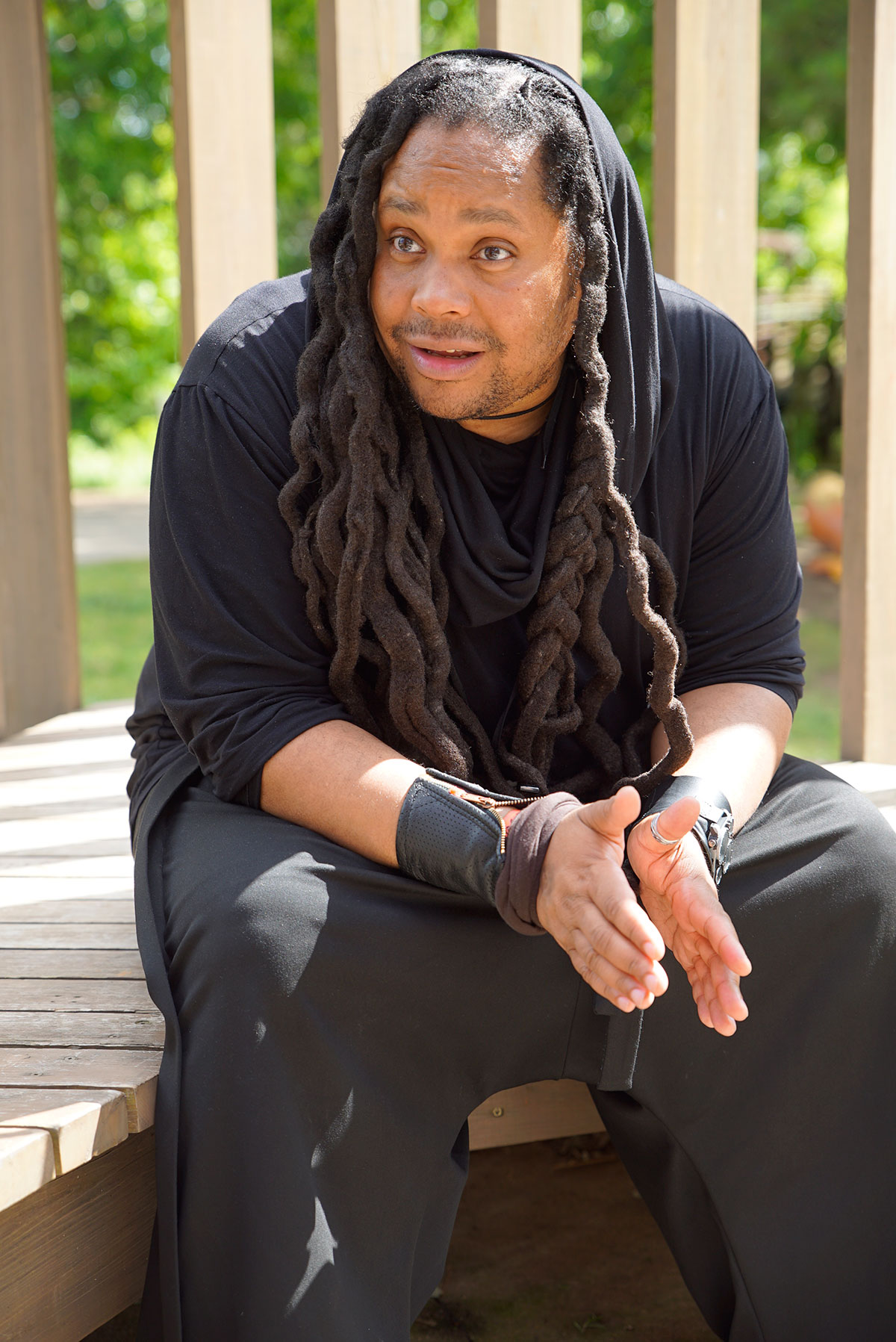The Sun over Egypt
“What is afro-futurism supposed to be”, Jamal Moss asks me, gesturing wildly. The musician from Chicago can hardly conceal his aggravation. We are at Moogfest in Durham, North Carolina. A couple of minutes ago he finished one of those panel discussions, that by now are part of every festival to create the appropriate theoretical-intellectual structure. He was supposed to reflect about the interplay of science fiction, astral jazz, psychedelic hip hop and much more together with Reggie Watts, Christian Rich, Janelle Monáe and Kimberly Drew – but he disapproved that it was from a strictly Afro-American point of view. “Why aren’t we just talking about the future of everyone? This segregation all the time!”, he continues.
It is not going to be the only subject that the 43-year-old will bring forward with such verve during our conversation – to be honest, it is more of a single lecture by him rather than a conversation; hardly a breath of air fits between his words and much less a response by me. Moss, who as a musician is mostly known as Hieroglyphic Being, is a single force of nature, a never-ending stream of consciousness, and it is necessary to let yourself get into it to be able to approach his music. “Nowadays a lot of people are not aware of the existence they are in anymore”, he continues. “They get distracted by radio, television and all those marketing things happening around them. So they do not get into tuning into the universe. When you do not do so, you have chaos inside you.”
Moss, who grew up with adoptive parents before he left home early because of different ideas for his life (getting a reputable education vs. making music) and lived on the street, now indeed exists in unison with the universe. Everything he does is aligned according to the cosmic calendar. “I am a sun, I am a planet, a moon”, he indicates, “and I know the stage of my existence and what I still have to fulfill before I become a black hole or a supernova or dust.”
You are not able to avoid mentioning the great American jazz musician Sun-Ran while talking about Moss and his Hieroglyphic Being. Sun-Ra claimed that he came from Saturn and together with his orchestra, and referring to ancient Egyptian myths and stylistic elements, he created a free-jazz soundtrack for his afro-escapism vibrating to the motto “space is the place”. Moss, who only wears black clothing, doesn’t follow the joy of color of Sun-Ra’s appearance, but the musical and structural influence is obviously inspired by him – just as by musicians like Miles Davis, John Coltrane, and Thelonious Monk, the works of early soul singers, as well as noise, industrial, Detroit techno and Chicago house (nourished by his mentors Adonis and Steve Pointdexter, who got him off the streets). Moss gathered all of this over the course of the last ten years, under his project names Africans With Mainframes (with Noleian Reusse), Insane Black Men (IBM), and Hieroglyphic Being, into an impressive opus, with releases on such renowned labels as Soul Jazz Records, Planet Mu, RVNG Intl. and his own imprint Mathematics Recordings.
Moss’s music is a real adventure playground, on which the rhythms frolic around with each other freely. A word like polyrhythmic is incapable to adequately reflect the complexity of the arrangements, just as reflection and movement are just the two poles of the range of impact of his music. “I have always been attracted to music that doesn’t get played on the radio”, Moss commences looking at his work. “Most of the music out there is commercial, and accordingly is manufactured and repeated over and over, I am attracted to things which are not the norm.”
While his last Album “We Are Not the First” (which he recorded together with J.I.T.U Ahn-Sahm-Bul and a band, that included amongst others Sun-Ra Arkestra member Marshall Allen) presented very free electronic jazz in the spirit of the almighty Sun-Ra, he now builds on his long history of club productions with “The Disco’s Of Imhotep“ (released on Ninja Tune). Imhotep was an ancient Egypt architect, who lived 2700 BC, and who was later on worshipped as a deity of healing and bringer of peace. Over the course of the nine tracks Moss works through the life of the originator of Egyptian medicine by sensitively musically seizing the narrative threads, while putting crystal clear techno next to pumping house tracks, atmospheric soundscapes, delicate deep house and abstract disco tracks. The most fascinating part of the music of Hieroglyphic Being is how all of these different identities of the dance floor merge into a coherent overall picture, just like a group of characters forms a community through dialogue.
Moss gesteht, sich selbst immer gefragt zu haben, wo all diese polyrhythmischen Strukturen und unterschiedlichen Einflüsse in seiner Musik herkämen. „Ich habe keine wirkliche musikalische Ausbildung genossen und eigentlich keine Ahnung von Dingen wie Noten und Akkorden. Das ganze musikalische Bingo ist mir fremd. Es muss also einen genetischen Grund dafür geben, warum ich all das kreieren kann.“ Um dieses Rätsel zu lösen, habe er erst neulich eine DNA-Untersuchung in Auftrag gegegen, mit dem für ihn dann wenig überraschenden Ergebnis, dass er in sich Anteile aus dem Senegal, Nigeria sowie ost- und nordafrikanischen Ländern trage, aber auch aus Finnland, Russland und Irland.
Moss admits, that he has been wondering where all these polyrhythmic structures and different influences of his music came from. “I never got a real musical training and don’t know all the musical structures, notes, keys, all this music bingo – but I felt there is some genetic reason behind my creations.” To unravel this mystery he recently got his DNA tested. He just got the results and not so surprisingly he comes from all different regions in Africa, from Senegal and Nigeria, and also from North- and Southeast Africa – but also from Finland, Russia and Ireland.
Moss ends his hour-long monologue with the surprising confession that he desires to have a family of his own. As long as he doesn’t have a wife and children there is no one to whom he could pass his legacy, his “sonic library which is the result of a sonic conversation with the galaxy”, on to after his death. This are worries that, despite all of the criticism of the traditional structures behind them, at least have been manifested creatively in such captivating songs like “The Shrine Of The Serpent Goddess“ and “The Way Of The Tree Of Life“ by him. On paper the former is just the minute-long opener to the album. But it is so much more: The alluring melody of said serpent goddess is Moss’s siren call into his world. And “The Way Of The Tree Of Life“ is the hymn to his life: he emerges mighty and confident, appears with the slightly stumbling beat, congenially surrounded by not decodable babble of voices, but still sensitive to the entanglements and the burden that life often holds ready for us, and thereby makes no secret of his vulnerability. The song, that breathes Detroit techno in every pore of its essence, is in the end one thing in particular: a wonderful ode to existence.
Translation by Denise Oemcke.




















